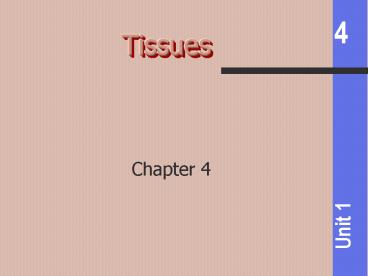Tissues - PowerPoint PPT Presentation
1 / 62
Title:
Tissues
Description:
Chapter 4 Tissues groups of cells with common role 4 basic types: Epithelial Connective Muscular Nervous Epithelial Tissue Cells close together continuous sheets ... – PowerPoint PPT presentation
Number of Views:138
Avg rating:3.0/5.0
Title: Tissues
1
Tissues
- Chapter 4
2
Tissues
- groups of cells with common role
- 4 basic types
- Epithelial
- Connective
- Muscular
- Nervous
3
Epithelial Tissue
- Cells close together continuous sheets
- Cover surfaces line cavities- always a free
surface Apical surface - Basement membrane of connective tissue
- No blood vessels- avascular
- Have a nerve supply
- High capacity for cell division.
4
Categories- Table 4.1
- Simple epithelium
- 1 layer of cells
- Stratified Epithelium
- more than 1 layer of cells
- Cell Shapes
- squamous, cuboidal, columnar, transitional
(change shape)
5
Simple Epithelium
- Squamous single layer of flat cells.
- Important for filtration (kidneys) or diffusion
(lungs capillaries) - Called endothelium when lining heart, blood and
lymphatic vessels - Called mesothelium when in serous membranes
6
Simple Squamous Epitheliumsingle layer of flat
cells
7
Simple Squamous Epitheliumsingle layer of flat
cells
8
Simple Squamous Epitheliumsingle layer of flat
cells
9
Simple Cuboidal Epitheliumcube shaped cells,
rounded nuclei
10
Simple Cuboidal Epitheliumcube shaped cells,
rounded nuclei
11
Simple Columnar EpitheliumMay be ciliated or
non-ciliated
12
Simple Columnar EpitheliumMay be ciliated or
non-ciliated
13
Simple Columnar EpitheliumMay be ciliated or
non-ciliated
14
Simple Columnar EpitheliumMay be ciliated or
non-ciliated
15
Pseudostratified Columnar appears stratified
nuclei at various levels
16
Pseudostratified Columnar appears stratified
nuclei at various levels
17
Stratified Squamous Epithelium
- Apical layer cells are flat
- Deep layers vary from cuboidal to columnar
- Cells in the basal layer divide and move upward
toward apical surface - Found in areas of surface wear tear
18
Table 4.1f figure 1
19
Table 4.1f figure 2
20
Stratified Cuboidal Epitheliumrare
21
Stratified Cuboidal Epitheliumrare
22
Stratified Columnar Epitheliumrare
23
Stratified Columnar Epitheliumrare
24
Transitional Epitheliumvariable in
appearancecells can stretch
25
Transitional Epitheliumvariable in
appearancecells can stretch
26
Glandular Epithelium-Endocrine
27
Glandular Epithelium-Endocrine
28
Glandular Epithelium-Endocrine
29
Glandular Epithelium-Endocrine
30
Connective Tissue
- Most abundant tissue type
- small cells far apart
- large amount of extracellular material (matrix)
- Often good blood supply
- Found between other tissues
- Classified using matrix characteristics
31
Connective Tissue Cellsvary with tissue type
- Fibroblasts- present in several tissues
- secrete fibers ground substance
- Macrophages- from monocytes
- Engulf bacteria cell debris by phagocytosis
- Plasma cells- develop from B lymphocytes
- Make antibodies
32
Connective Tissue Cells
- Mast cells- near blood cells
- part of reaction to injury- histamine
- Adipocytes fat cells or adipose cells
- Store triglycerides (fat)
33
Extracellular Matrix
- Fluid, gel or solid plus protein fibers
- Ground substance-between cells and fibers
- Fibers- 3 types
- Collagen fibers very strong flexible
- Elastic fibers smaller stretch and return to
original length - Reticular fibers provide support strength
- found in basement membranes organ support
34
Figure 4.2
35
Loose Connective Tissue
- Areolar
- Adipose
- Reticular
36
Table 4.2a figure 1
37
Table 4.2a figure 2
38
Table 4.2b figure 1
39
Table 4.2b figure 2
40
Table 4.2c figure 1
41
Table 4.2c figure 2
42
Classification
- Dense Connective tissue
- Dense regular
- Dense irregular
- Elastic
43
Table 4.2d figure 1
44
Table 4.2d figure 2
45
Table 4.2e figure 1
46
Table 4.2e figure 2
47
Table 4.2f figure 1
48
Table 4.2f figure 2
49
Cartilage
- Dense network of collagen elastic fibers
embedded in chondroitin sulfate - stronger than dense fibrous
- Cells chondrocytes
- Occur singly or in groups
- Found in spaces called lacunae
- Surrounded by perichondrium
- No blood vessels or nerves
50
Classification - Cartilage
- 3 types
- Hyaline- fibers not easily visible
- Fibrocartilage- fibers visible
- Strongest type. E.g. in vertebral discs
- Elastic- chondrocytes in threadlike network e.g.
ear cartilage
51
Table 4.2g figure 1
52
Table 4.2g figure 2
53
Table 4.2h figure 1
54
Table 4.2h figure 2
55
Table 4.2i figure 1
56
Table 4.2i figure 2
57
Bone Osseous Tissue
- More dense matrix includes Calcium phosphorus
salts - Details in Chapter 6
58
Liquid Connective Tissue
- Blood- matrix plasma
- More in chapter 14
- Lymph- matrix like blood but with less protein
- More in chapter 17
59
Muscular Tissue
- large, elongated cells
- contractile cells
- Skeletal muscle tissue -named for location
- Cardiac muscle tissue- forms wall of heart
- Smooth muscle tissue found in walls of hollow
organs
60
Neural Tissue
- Nerve cells neuroglia
- Neurons- convert stimuli into nerve impulses and
conduct them - Neuroglia do not generate nerve impulses.
- Serve supportive functions
61
Body Membranes
- 4 types of body (not cell) membranes
- Mucous Membranes line body cavities opening to
exterior - Secrete mucus
- Serous Membranes- surround moving organs
- Secrete serous fluid
- Synovial Membranes- line cavities of some joints.
- Secrete synovial fluid
62
Tissue Repair
- New cells from stroma or parenchyma
- Epithelial cells originate from stem cells in
defined areas of tissue layer - Bone regenerates readily, cartilage poorly
- Muscular tissue can replace cells but slowly
- Nerve tissue is poorest at replacement although
some stem cells seem to be available. - Replacement from stroma gt scar tissue
functional loss.































